In this blog, I want to highlight the incredible Charleston Trust that looks after Charleston Farmhouse in Firle (near Lewes.) Read to the end for my suggestions on where else to visit for a weekend break.
The Legacy of the Bloomsbury Group
Charleston is an idyllic farmhouse overlooking the weald in Sussex. Charleston was more than just a home; it was a hub for intellectual and artistic exchange. The Bloomsbury Group, which included figures like Virginia Woolf, John Maynard Keynes, and E.M. Forster, gathered here to discuss ideas, create, and challenge societal norms. For art history, literature, or philosophy fans, visiting Charleston is an opportunity to connect with the birthplace of ground breaking thought and creativity.
Vanessa Bell moved to Charleston Farmhouse in 1916 with her two young sons, her fellow artist friend Duncan Grant, with whom she lived for 50 years, and his friend David Garnett. Duncan and David were against fighting in the war and sought refuge at Charleston, choosing farming over fighting.
Walking through this beautiful, once-loved family home, it’s difficult to not smile wistfully at the hand painted art with childish wonder. It’s an enchanted place with potent individuality. Most of us grew up in a home where art time was scheduled on a plastic sheet up the dining table. If lucky, an odd masterpiece would end up pinned to the kitchen fridge. This is a house that wasn’t intending to be tasteful or have restraint. Charleston Farmhouse is a canvas encapsulating the personalities of its artist owners around every corner, from the picture rails to the doors, fireplaces and furnishings.
The kitchen
The kitchen is the first room you are greeted with and is largely untouched. It has a large oil-filled Aga stove, which would have been used by the family cook, Grace Higgens, who worked there for fifty years. Although a practical room, it hints at the owners’ personality with an oil-filed beaded lamp over the kitchen table and a cupboard painted by Vanessa hosting an Omega dinner service. There is also an assortment of cups made by Vanessa’s son, Quentin, that still hang on hooks under the built-in staircase that rises two floors to the attic. This is where the servants slept and was known as High Holburn. A whimsical reference to the London thoroughfare running to the south of Bloomsbury.
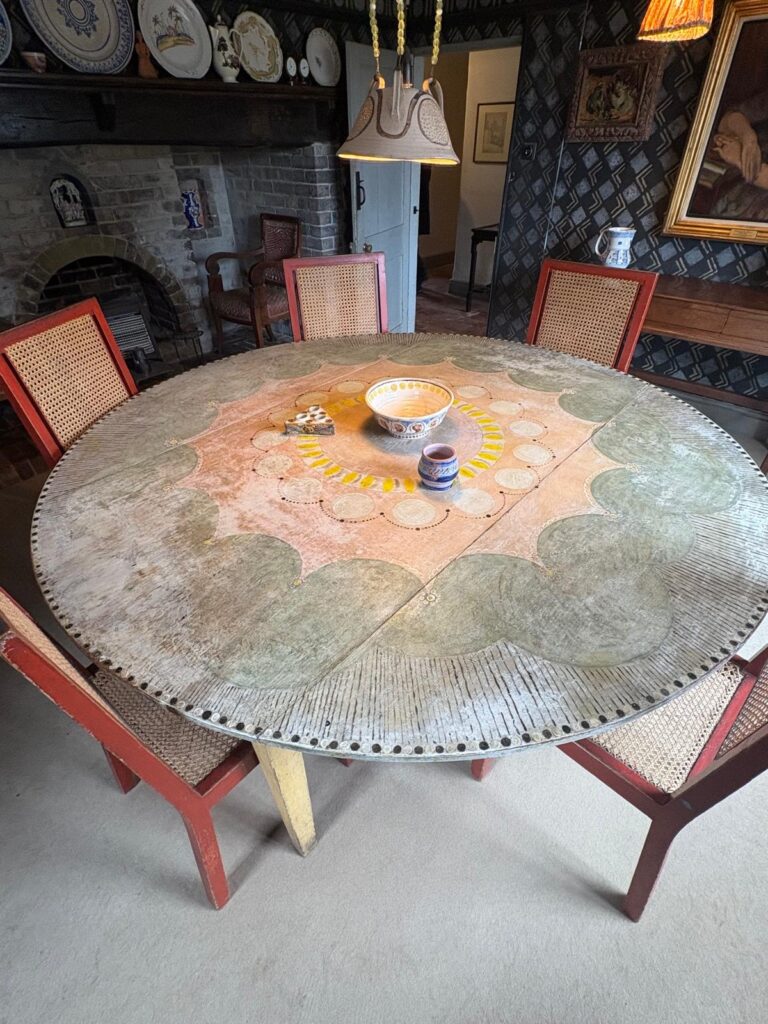
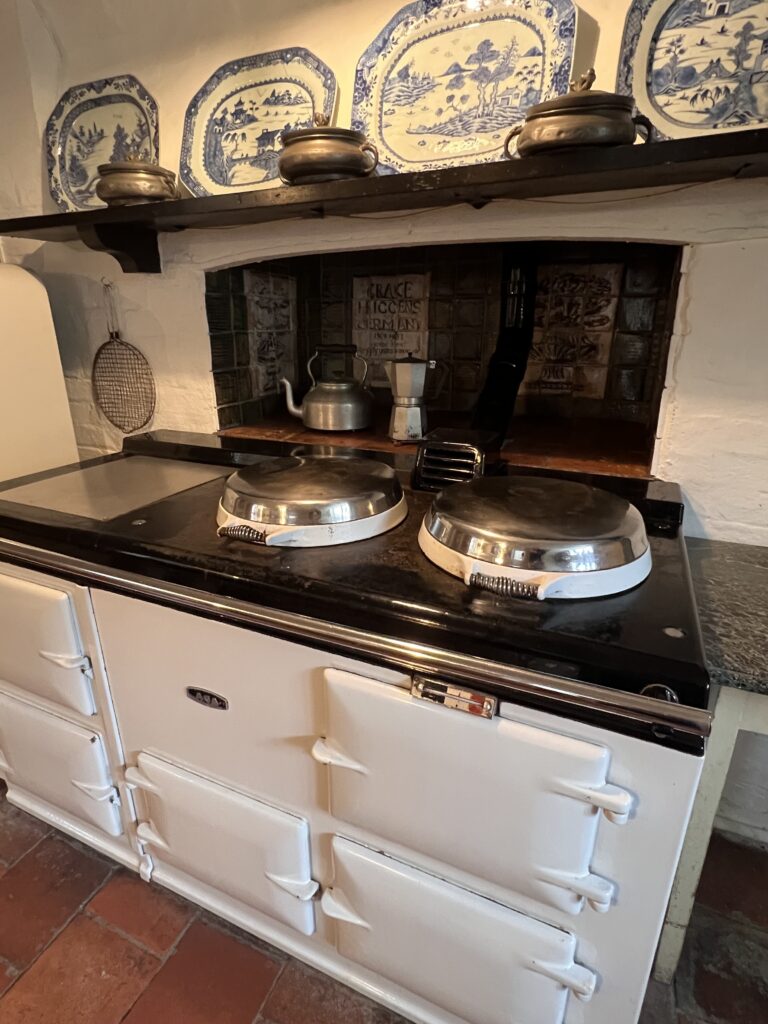
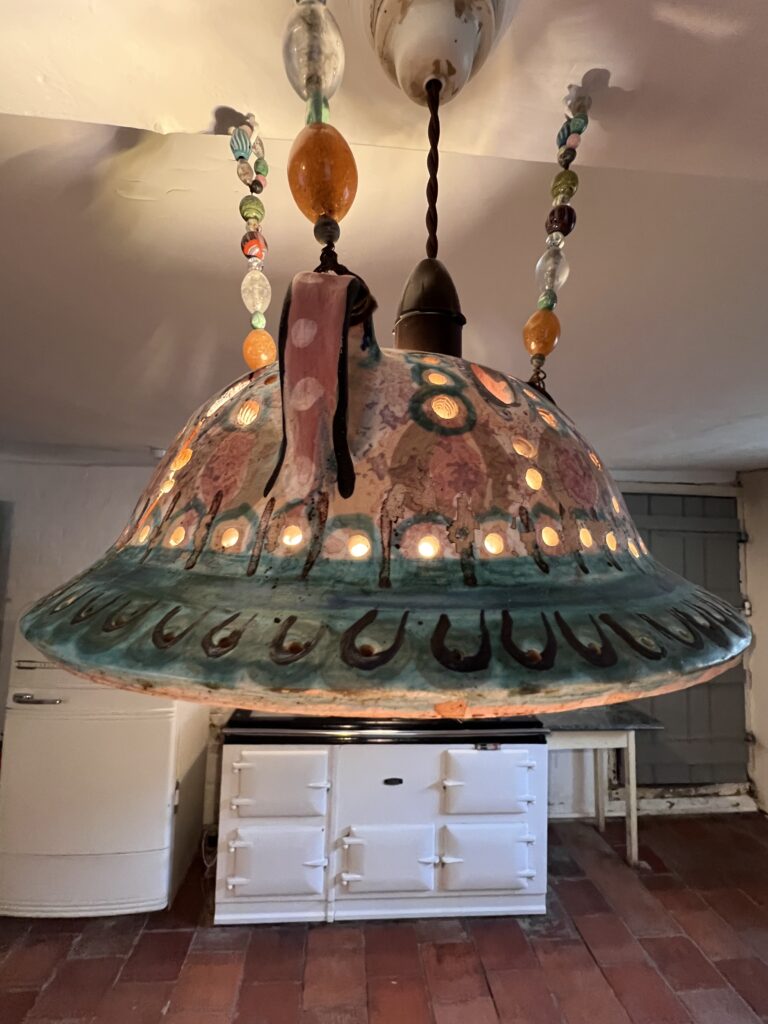
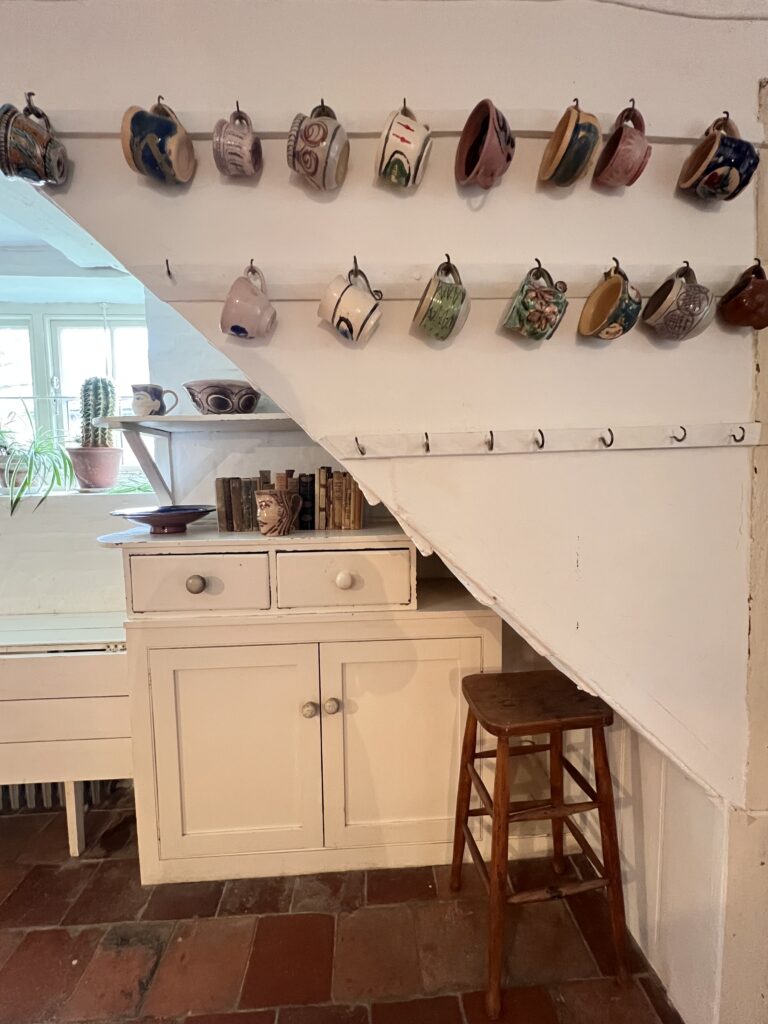
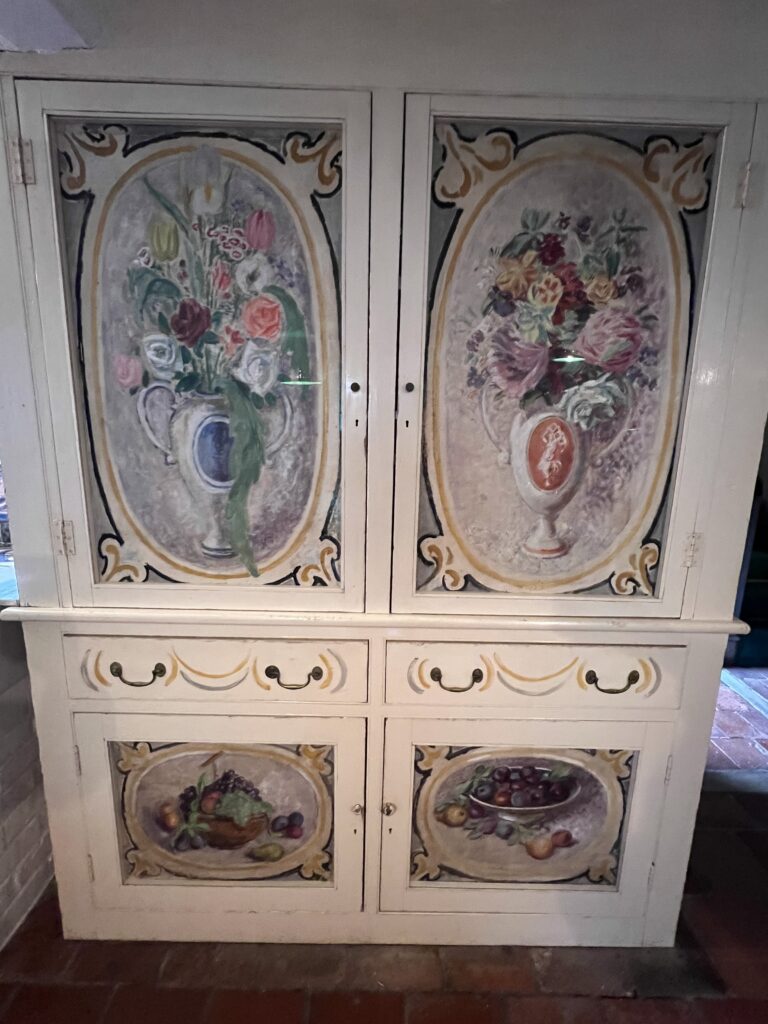
Clive Bell’s study
As you move through the house, from the dining room to Clive Bell’s (Vanessa’s husband) central study, there is hardly an area untouched by David or Vanessa’s personal expression. This was a cold room when Vanessa moved in, especially in the first winter. So, they built a large rectangular fireplace. The room’s warmth attracted the children, who would collect blue clay from the pond and use the fireplace as a kiln for their clay bricks that would then be used to make hideouts and fortresses. The study was also a gathering point for tea and marrow jam! The room continued in popularity becoming the favourable place for the boys schooling with Mrs Brereton.
You’ll notice Vanessa’s hand painted fireplace with circle motifs. It’s easy to miss if the door is ajar when wandering through, but Duncan painted both panels in the doors. It’s a cosy room with many books and hanging art from the picture rail. There is also an antique French chair upholstered in a fabric called ‘West Wind’ designed by Duncan in 1932.

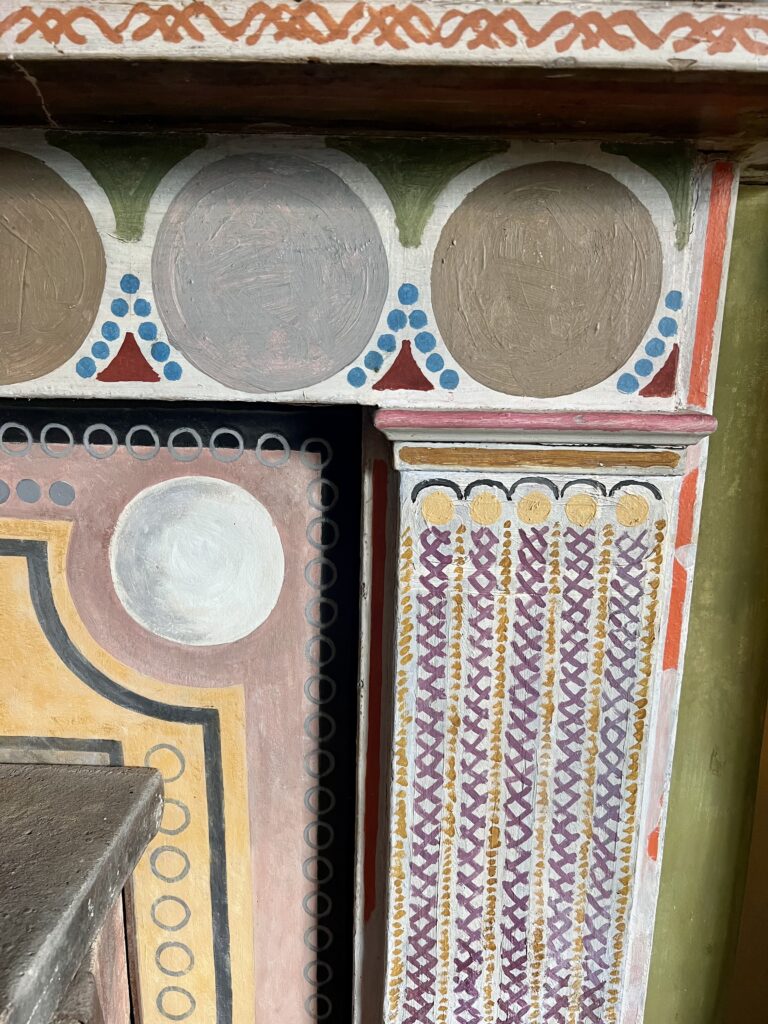
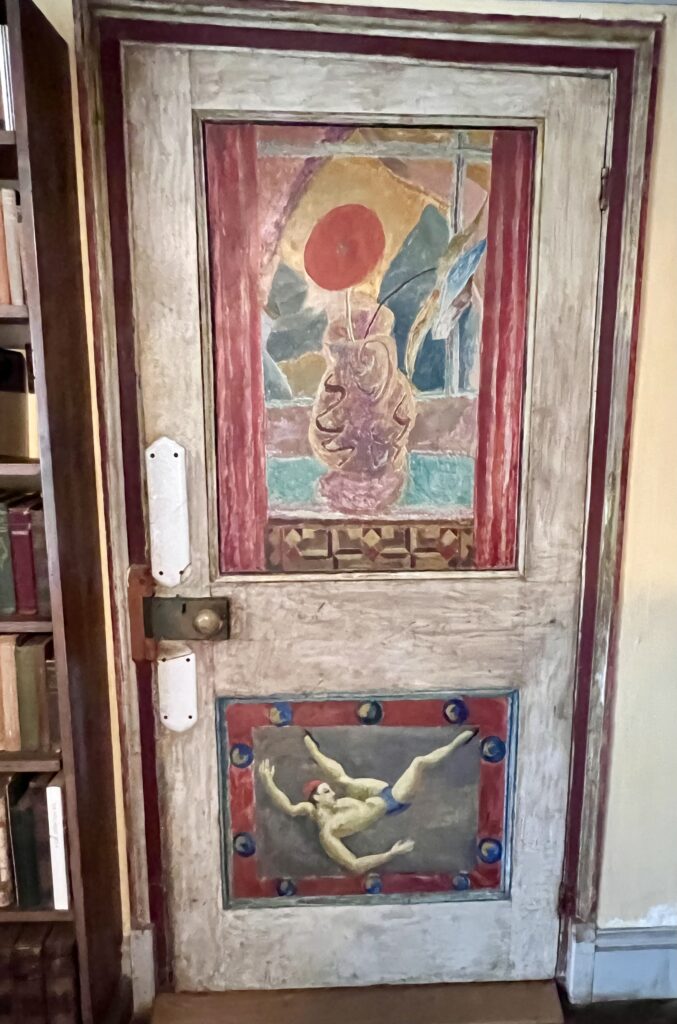
The Garden Room
After dinner, guests would move to this welcoming room, where the French doors opened to the garden. You can imagine the after-dinner conversations happening here in the big, comfy armchairs next to the fireplace with a shot of brandy. Over the fireplace are Duncan’s figures, who once supported a mirror. The fish rug was also designed by Duncan in the 1920s. Vanessa and Duncan stencilled a paisley pattern on the walls in the 1940s. The walls are full of art, including Quentin’s copy of Picasso’s early Pots et Citrons artwork. The family owned the original and it was sold on. They missed it so much that Quentin decided to paint a copy.
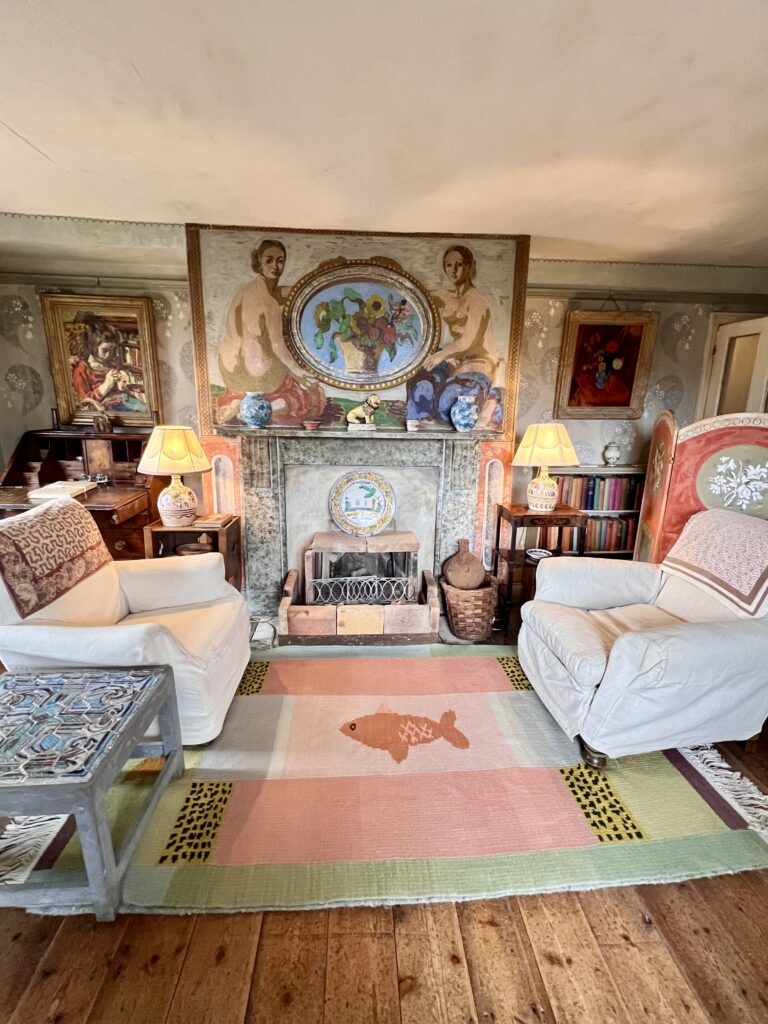

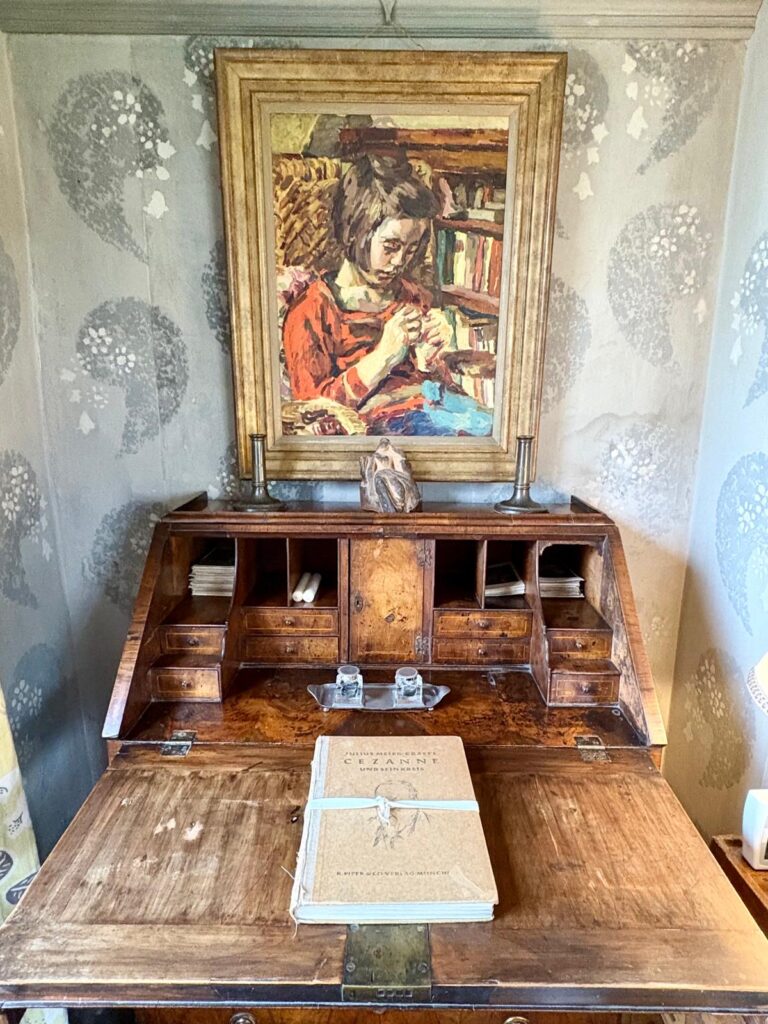
The studio
The creative heart of Charleston, the studio, is where much of the magic happened. This light-filled space served as an artist’s sanctuary, with easels, paints, and brushes scattered across the room. The walls carry the marks of their creators, adorned with painted motifs and colours that reflect the joy of making art.
The mantlepiece is still cluttered with Duncan’s photographs, invitation cards, and pictures from newspapers and magazines. Original pottery still lives proudly on display such as a stripy plate, a patterned vase, and a ceramic coffee pot made by Quentin, providing a feel for how the house would have been lived in.
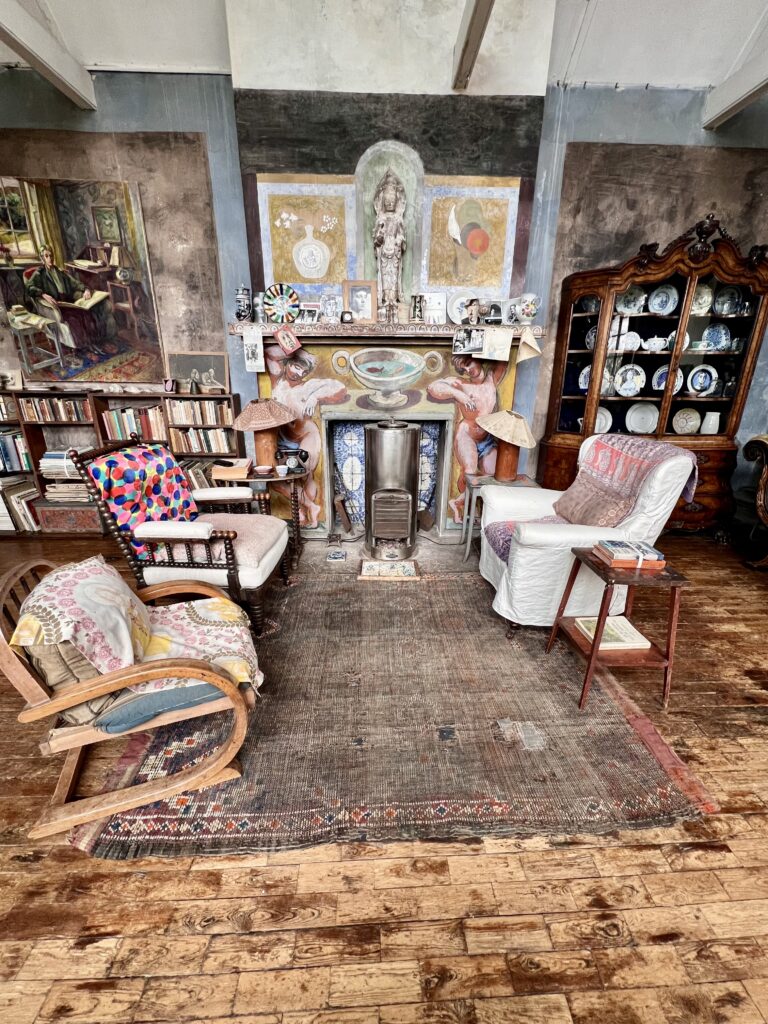
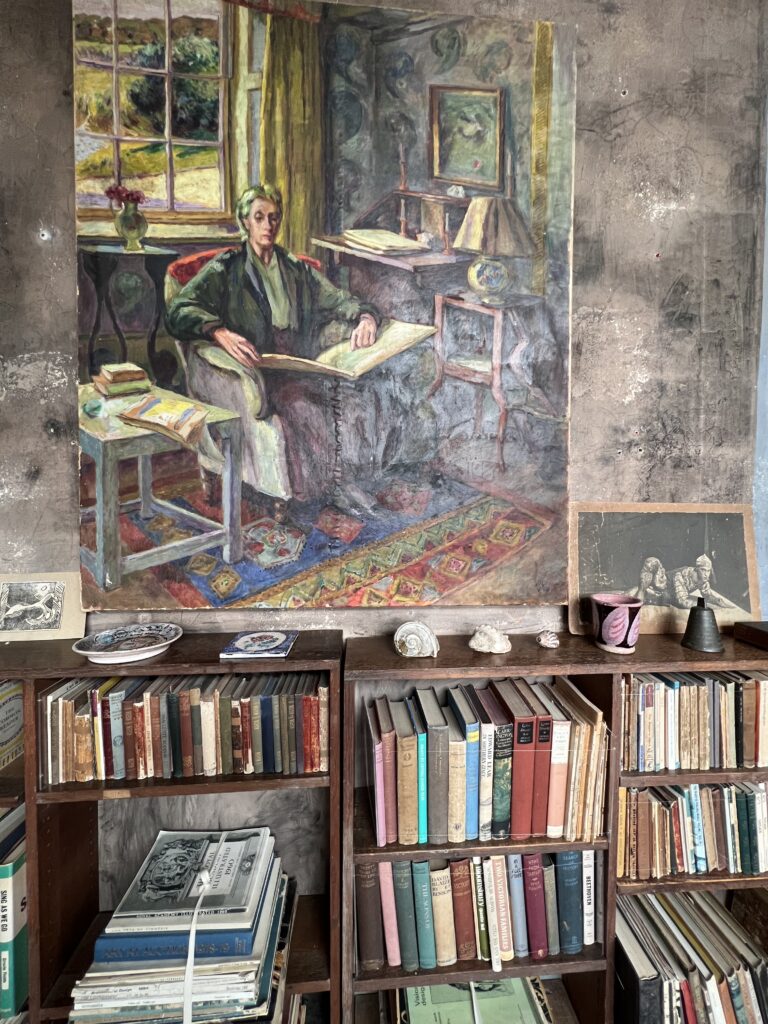
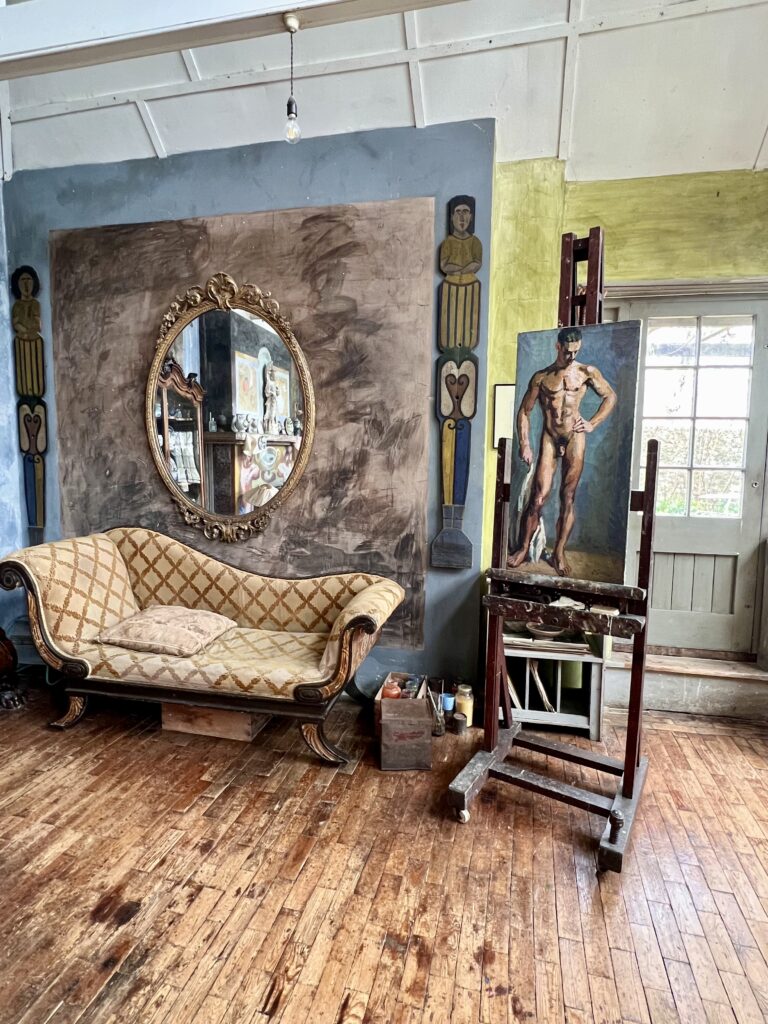
The Library
This room was Vanesa’s bedroom until she moved out in 1939 when Clive used it as part of his ‘suite’, which contained a bedroom, bathroom, and library. Apart from the collection of books, the room still contains two eighteenth-century-style Venetian chairs upholstered in Duncan’s ‘Grapes’ fabric.
The north-facing window gives a lovely view over the gardens. In 1917, when this was Vanessa’s bedroom, Duncan painted Henry, the family’s lurcher, below the window and the cockerel above it to guard her at night and wake her up in the morning. This is one feature of the house that makes me smile – an artist’s impression of the modern house alarm and alarm clock!
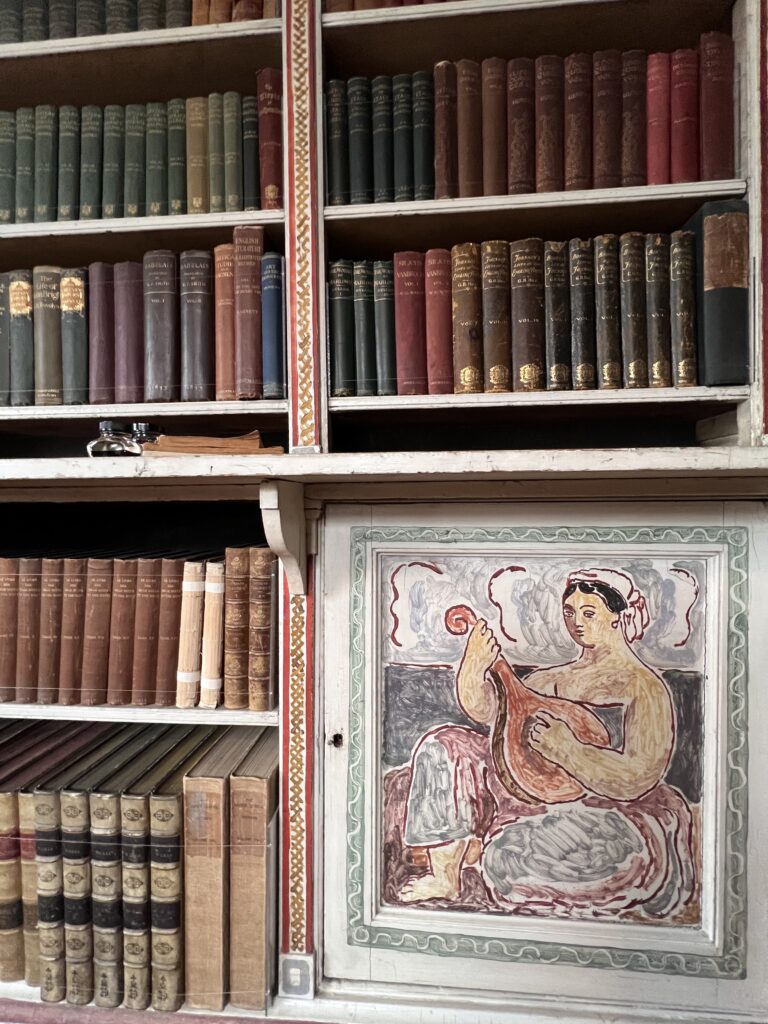
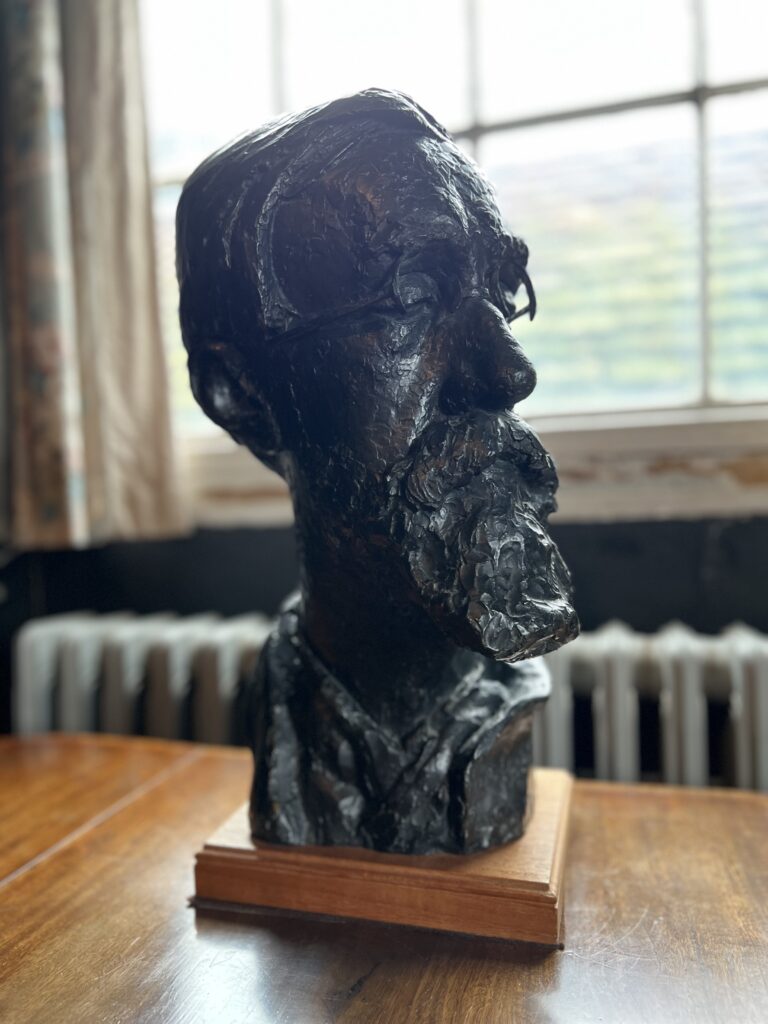
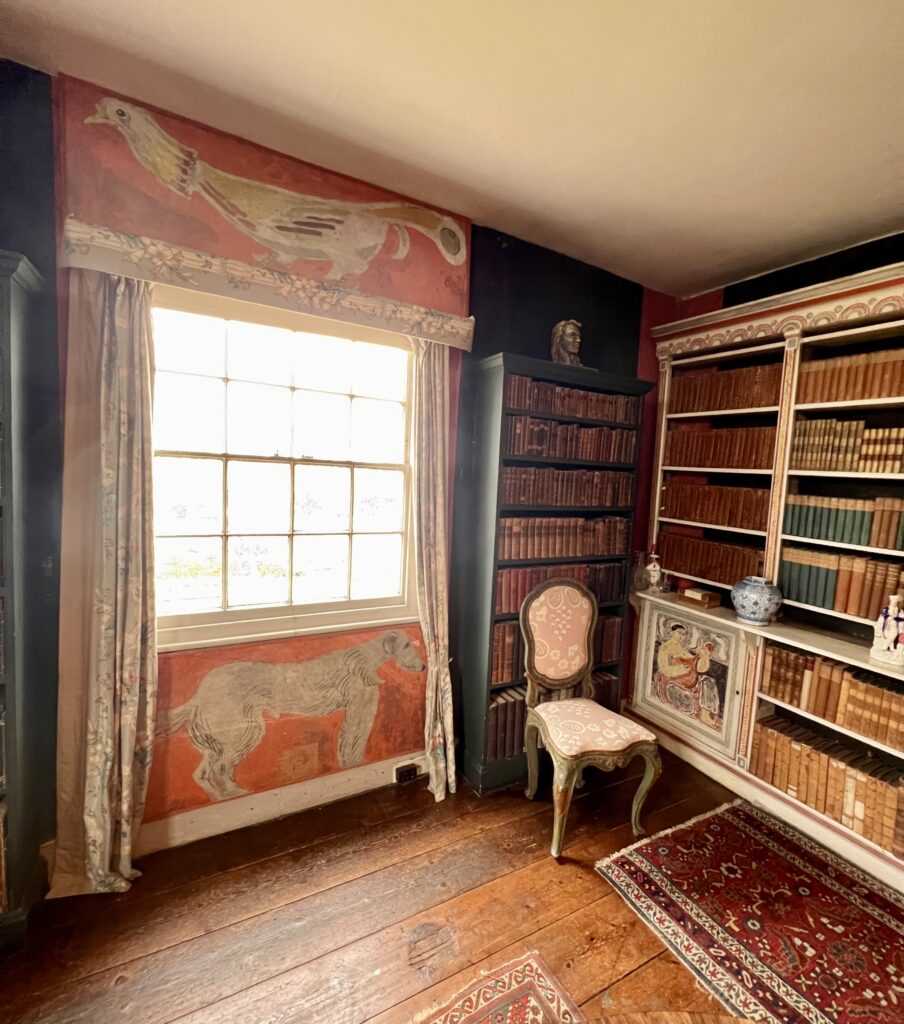
Upstairs
As you continue upstairs, the same artistic flair continues. There are bedrooms for Maynard Keynes, Clive Bell, Duncan Grant, a spare room, and a bathroom.
Maynard’s room stood out for me. It contains Vanessa’s old bed, which has a headboard designed by Duncan. The bed was painted in 1917 and resembles Morpheus, the god of sleep. The Latin poet Ovid described Morpheus as sending dreams and visions of human forms to the sleeper. The design has a 3D nose, which must have made it difficult to sit up against it! The room also contains one of Quentin’s experiments with stained glass in the internal door. The picture in the gallery below is of Maynard, painted by Duncan.
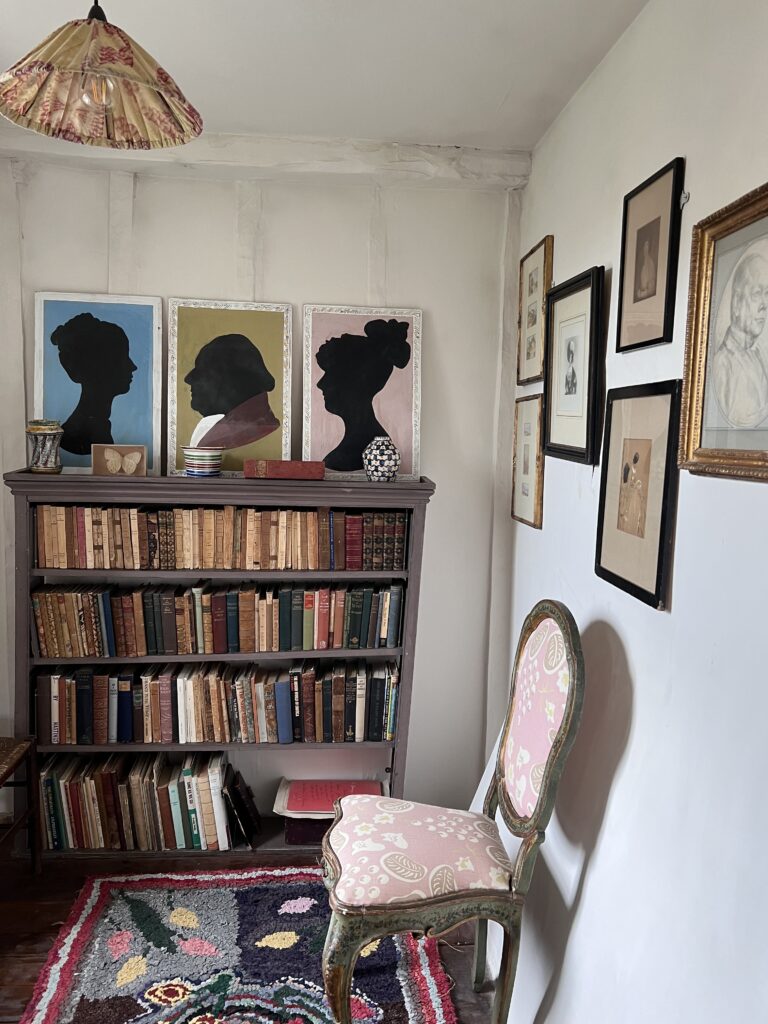
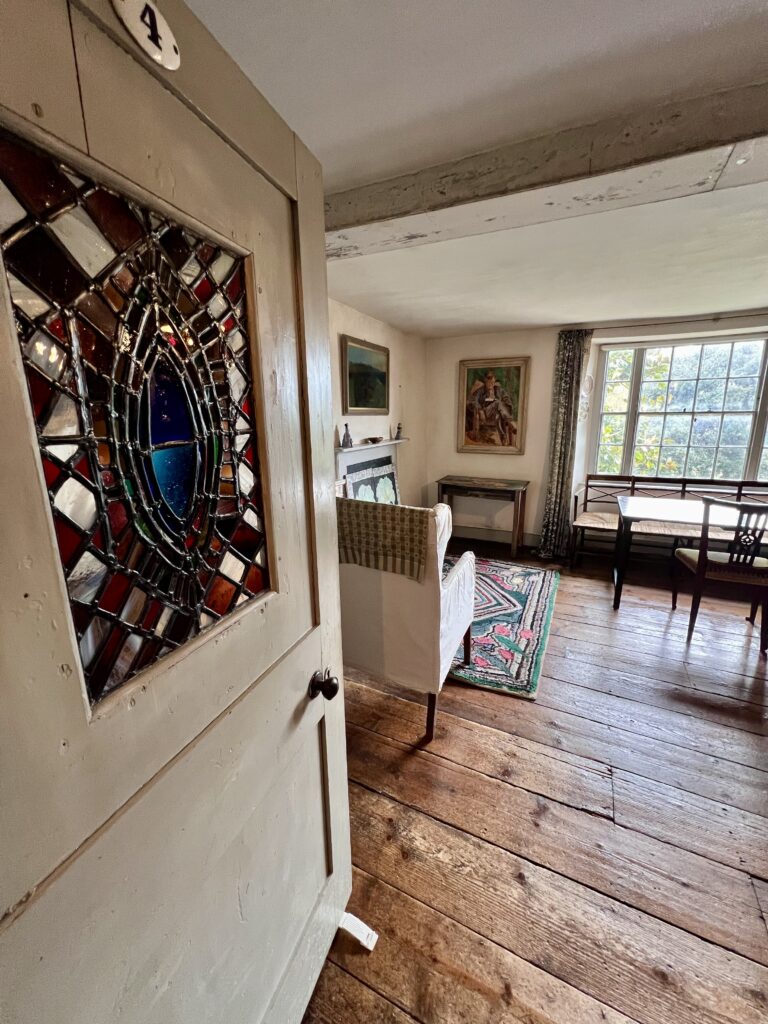

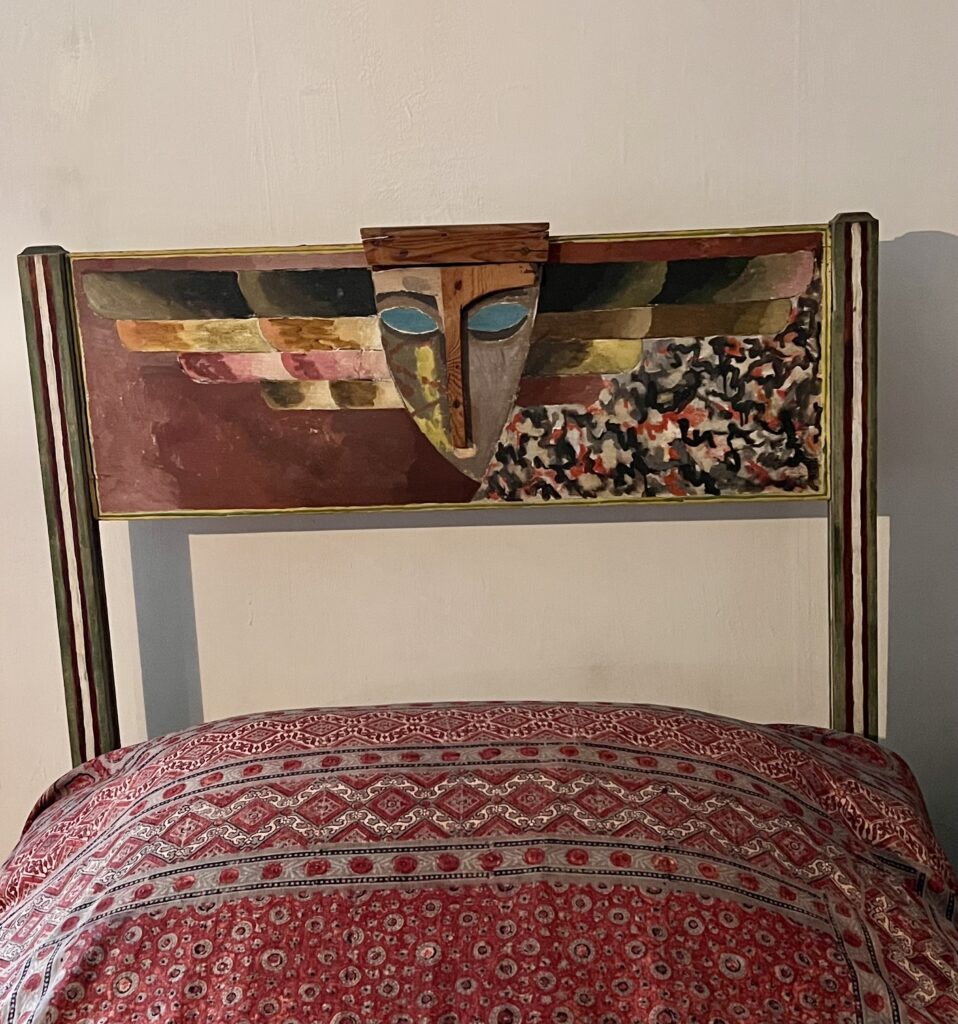
Garden
Charleston farmhouse garden in the summer resembles a traditional English cottage garden with a beautiful pond which contains the Levitating Lady designed by Quentin in 1973.
It’s a painter’s garden full of colour full of hollyhocks, dahlias, zinnias and mallow in every colour. The flint and brick wall skirting the enclosed garden has a row of antique heads, and the pathway is lined with muted silver-grey cotton lavender. The lawn is surrounded by flower boarders scented with tobacco plants.
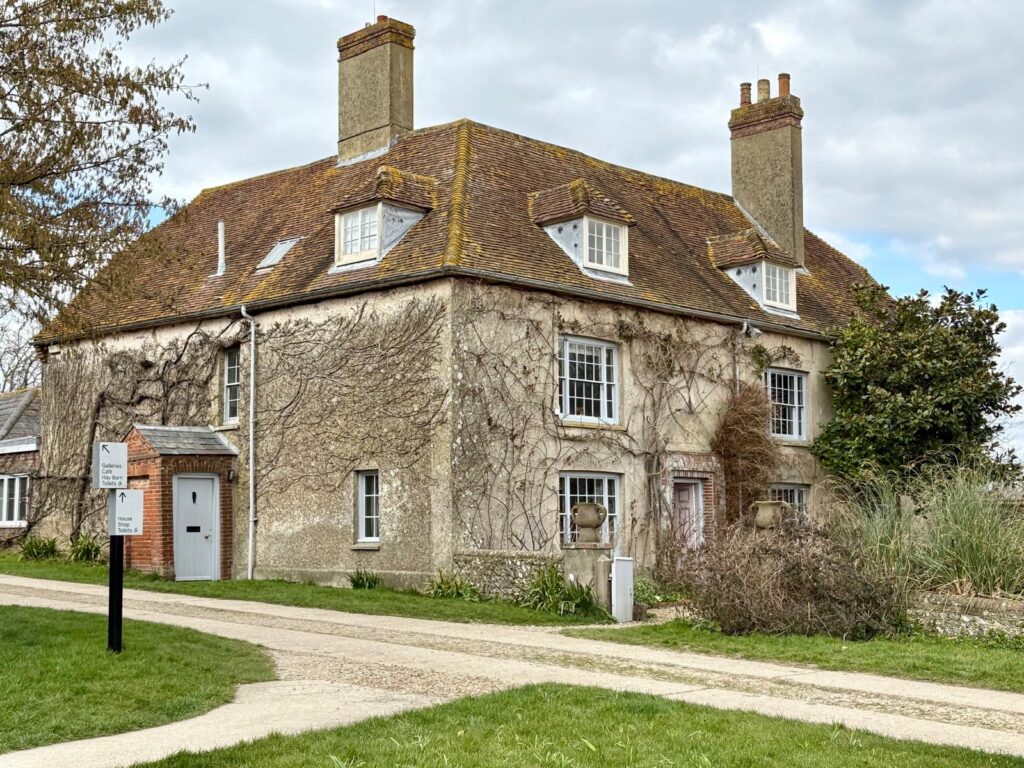
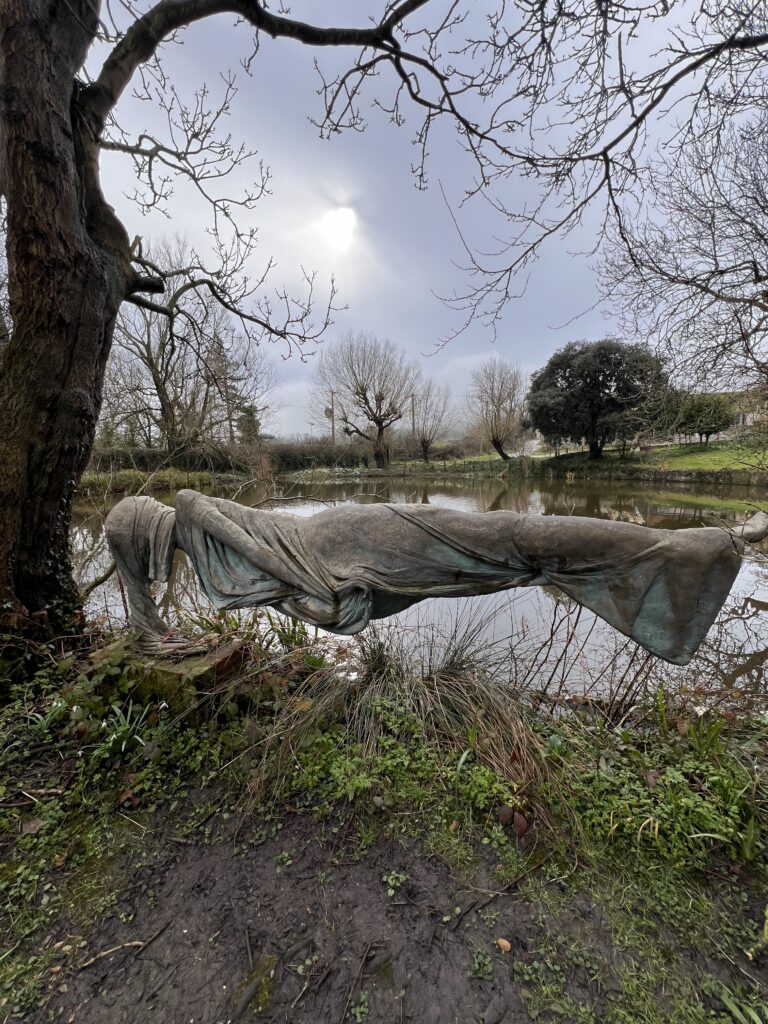
Charleston gallery in Firle
Once you have finished wandering around Charleston Farmhouse, you can visit the adjoining gallery. The exhibitions change regularly, so there is always new art to admire. The gallery features varied artists from the post-impressionist era to modern up-and-coming artists.
To show the diversity in exhibitions, the below gallery features the different artists on my last visit. The first exhibition was Investing Post Impressionism and showcased art such as Renoir’s Young Woman Seated and Peasant Women Digging by Van Gough.
The third picture is the work of artist, Izumi Kato. He usually works between Tokyo and Hong Kong and is inspired by post-impressionist painters, Van Gough and Japanese painter Jakuchu. Charleston tends to show artists with a similar multidisciplinary and experimental approach of that to the Bloomsbury’s. Izumi’s work is strikingly different!

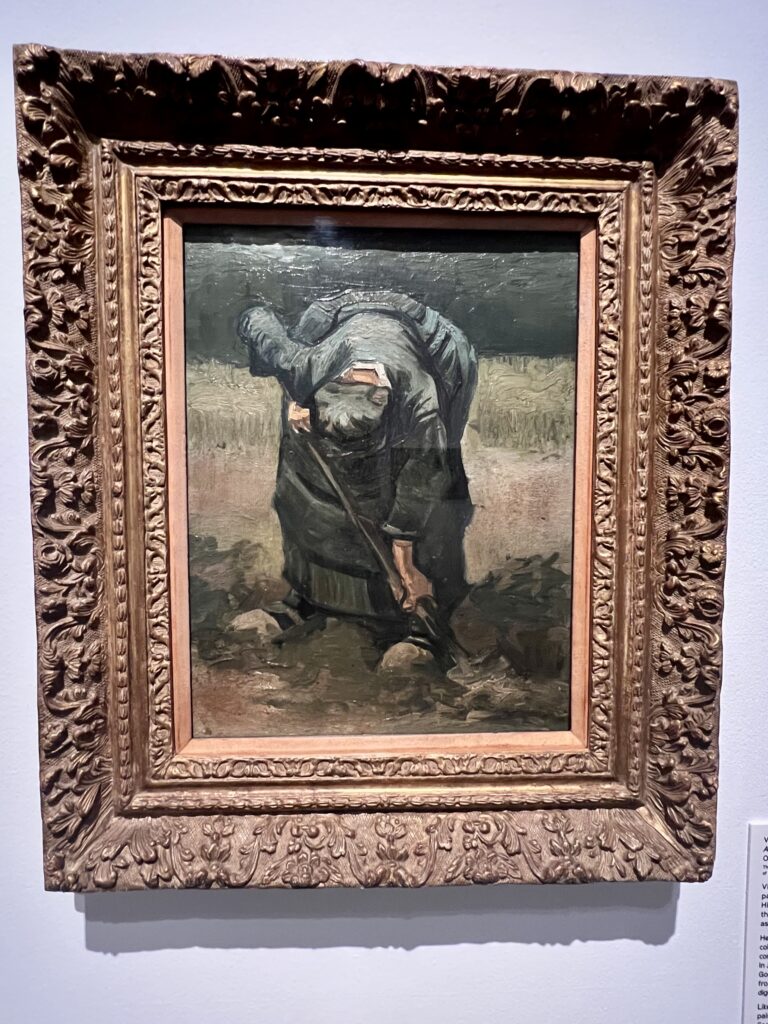

I’m thankful for the trust in keeping the house in a condition that allows visitors to immerse themselves in Vanessa and the Bloomsbury Group’s lives. But, it would also be nice to close the door to tourists and spend a weekend there; a testament to the homely connection this house bestows.
Recommendations for a weekend break
Between the house and the adjoining gallery, you can easily spend a few hours at Charleston. If you are travelling there for the day, I recommend having lunch in Lewes and combining a visit to the Charleston gallery in Lewes or treasure hunting in the many antique shops in the town. Charleston Gallery in Lewes has separate exhibitions to the gallery in Firle and they often showcase the Bloomsbury group. Below are two male nudes by Duncan Grant and Vase, Bowl & Flowers by Vanessa Bell.
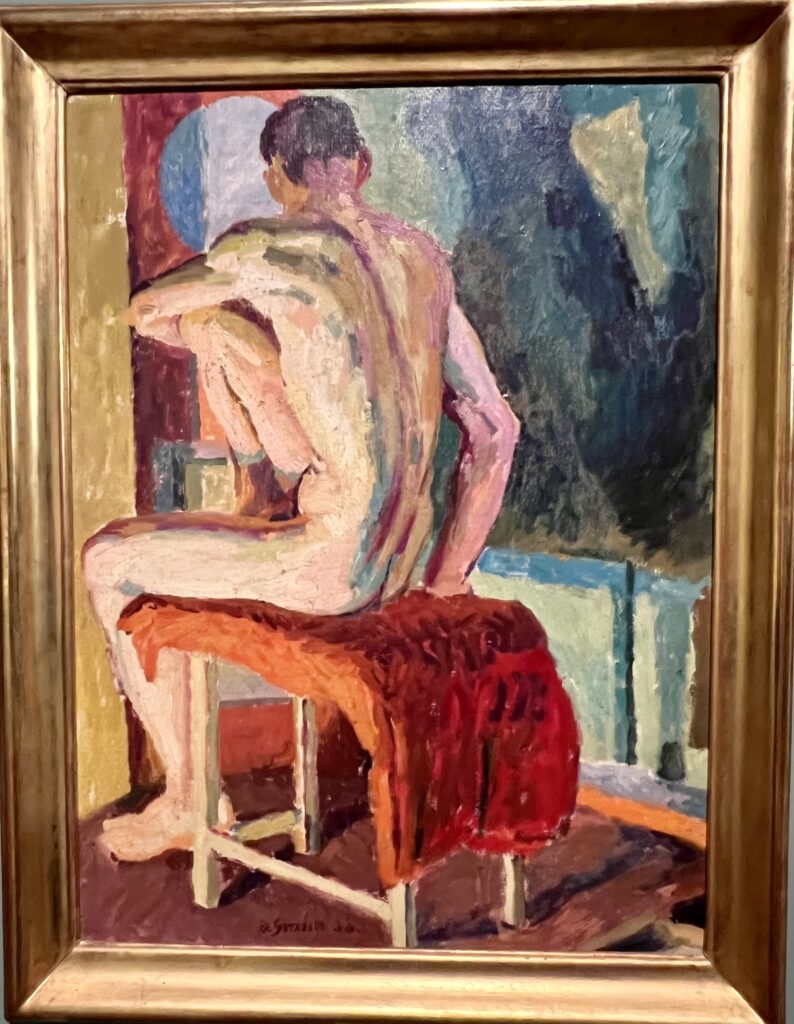
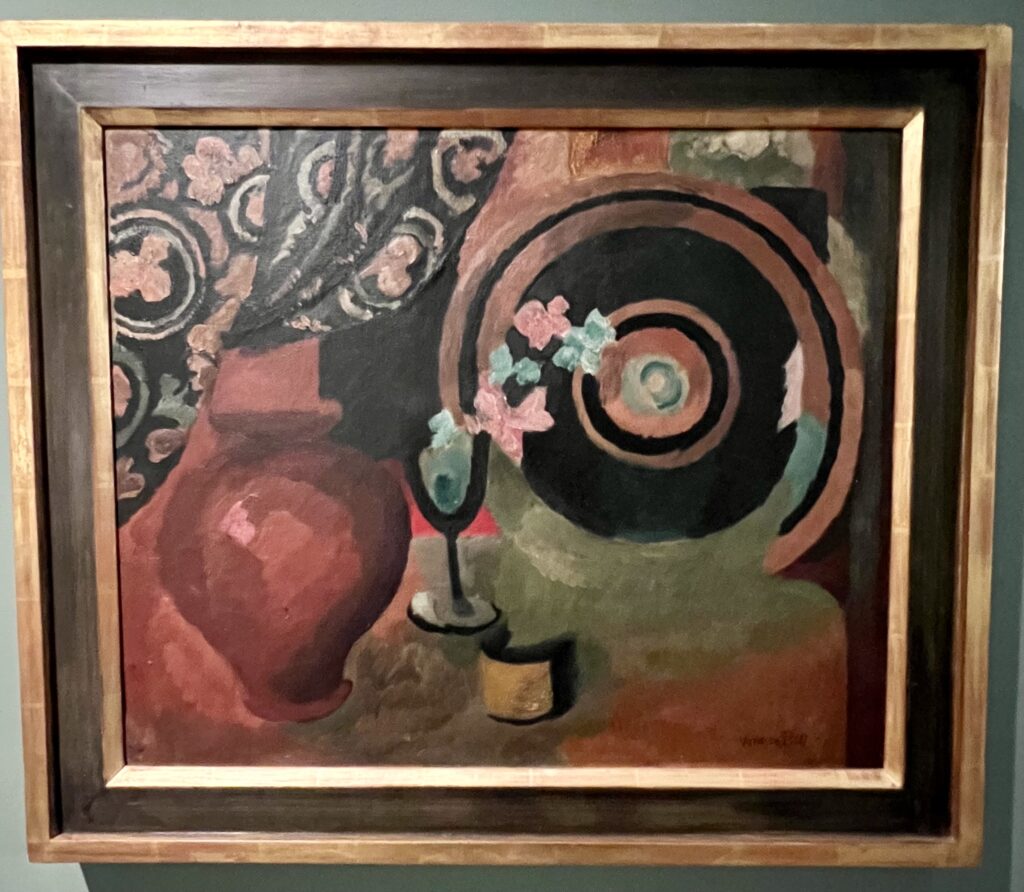

There are many places to eat in Lewes, but the Mother Bhumi street food van selling battered vegetables with mango chutney dip is a favourite snack-on the go if you are there on a Saturday.
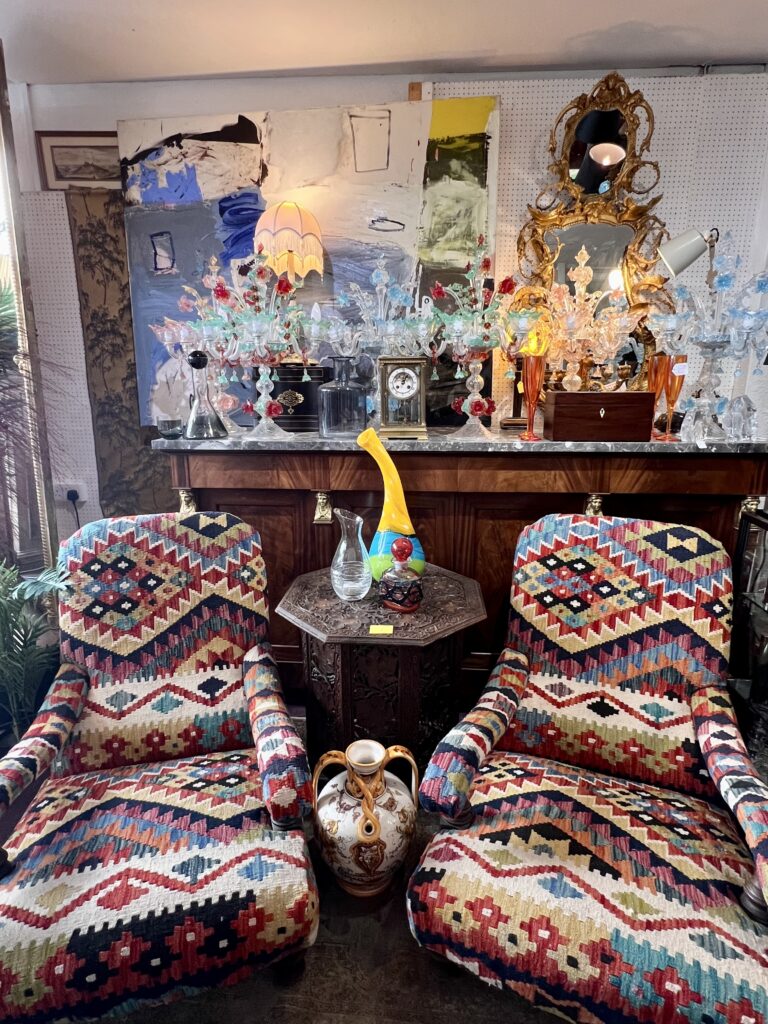
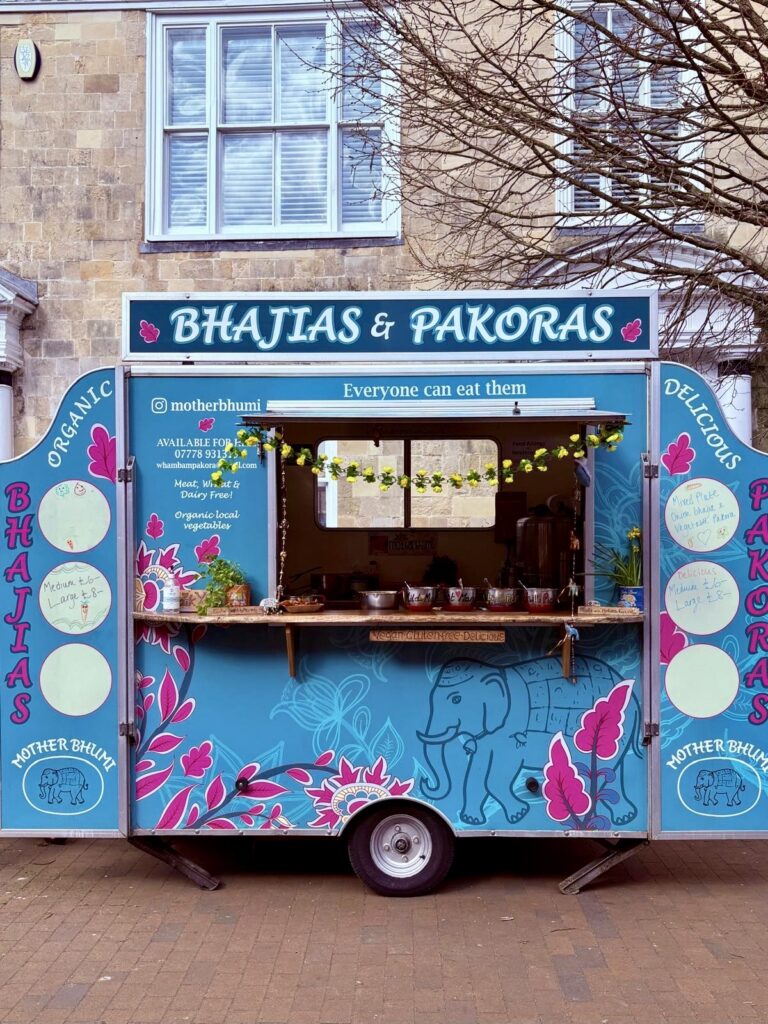
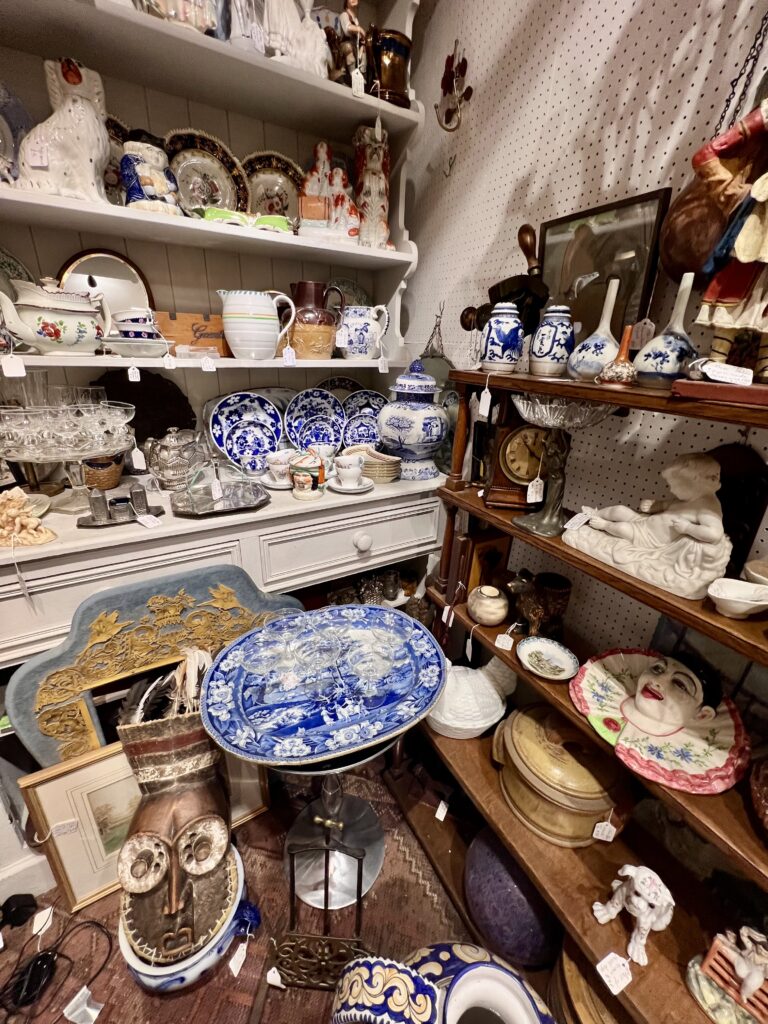
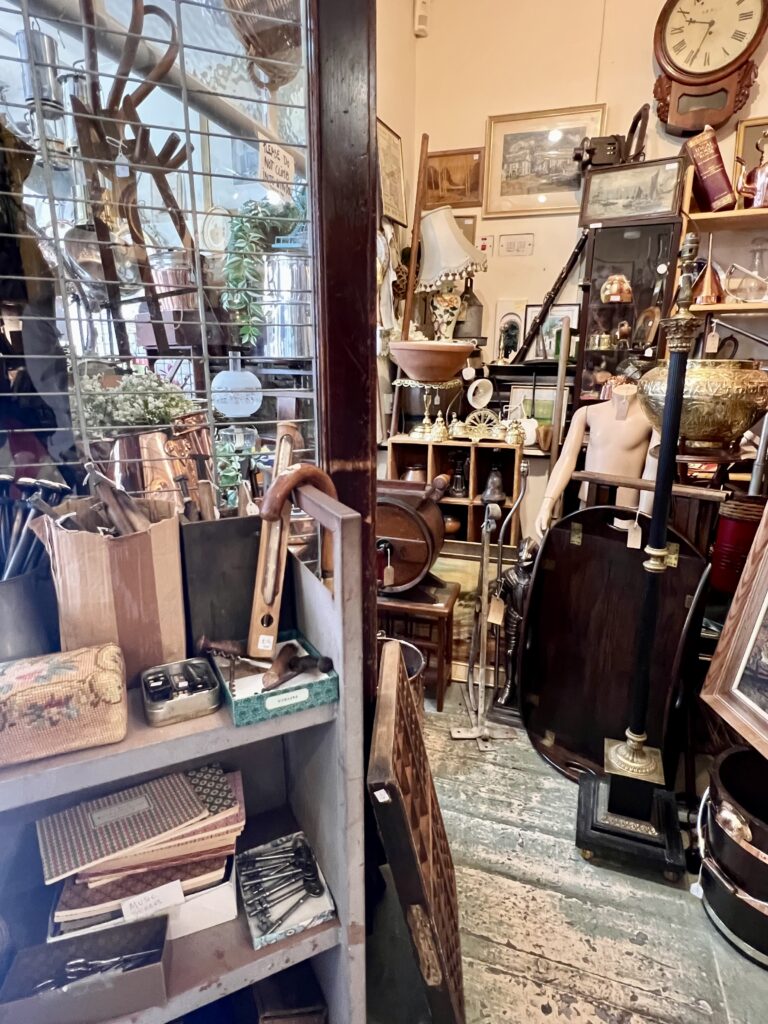
If you stay longer and have a car, you could visit the small rural church of St Michael & All Angels in Berwick, which has links to the Bloomsbury group. Duncan Grant, Vanessa Bell and her son Quentin Bell were commissioned to decorate the interior of the church.
The Chancel Arch is beautiful and has a powerful energy when you sit and reflect. The mural was designed by Duncan and depicts Christ having offered himself on the cross, now enthroned in heaven with angles worshiping him.
The church welcomes visitors and sells brochures explaining the meaning behind the murals.
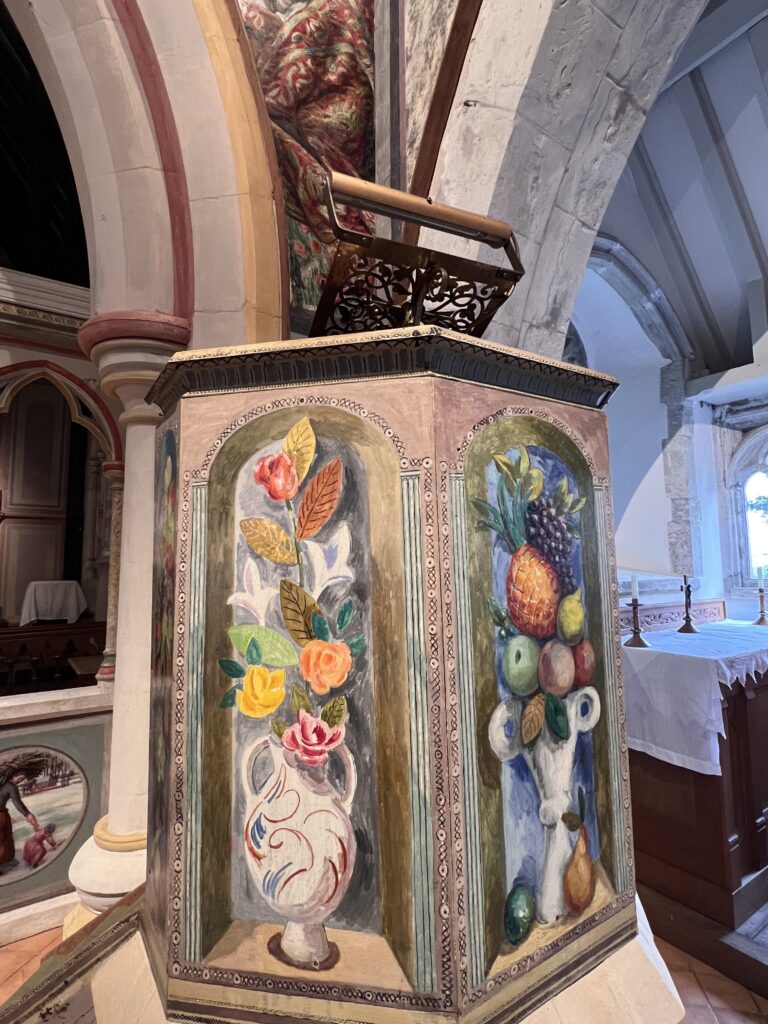

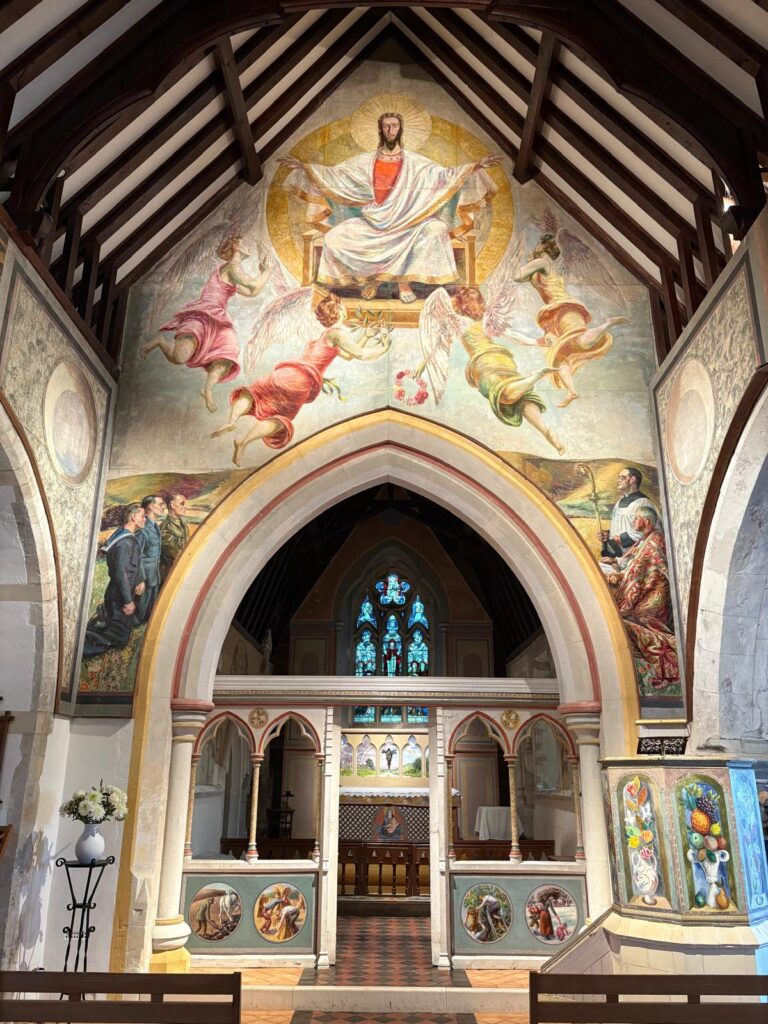
In the town, you could also visit Anne of Cleves house, or Lewes Castle, built in the 11th century which has beautiful views over the town. Harvey’s Brewery is also a good option, which produces cask, keg, can and bottled ales. You can book a tour to visit the historic Grade II Listed Building, learn about the art of the craft, and enjoy some ale samples.
Lastly, Brighton is only a 20-minute drive away and has many places to visit for art and culture and would make a fantastic second day for a weekend-stay.



Leave your thoughts